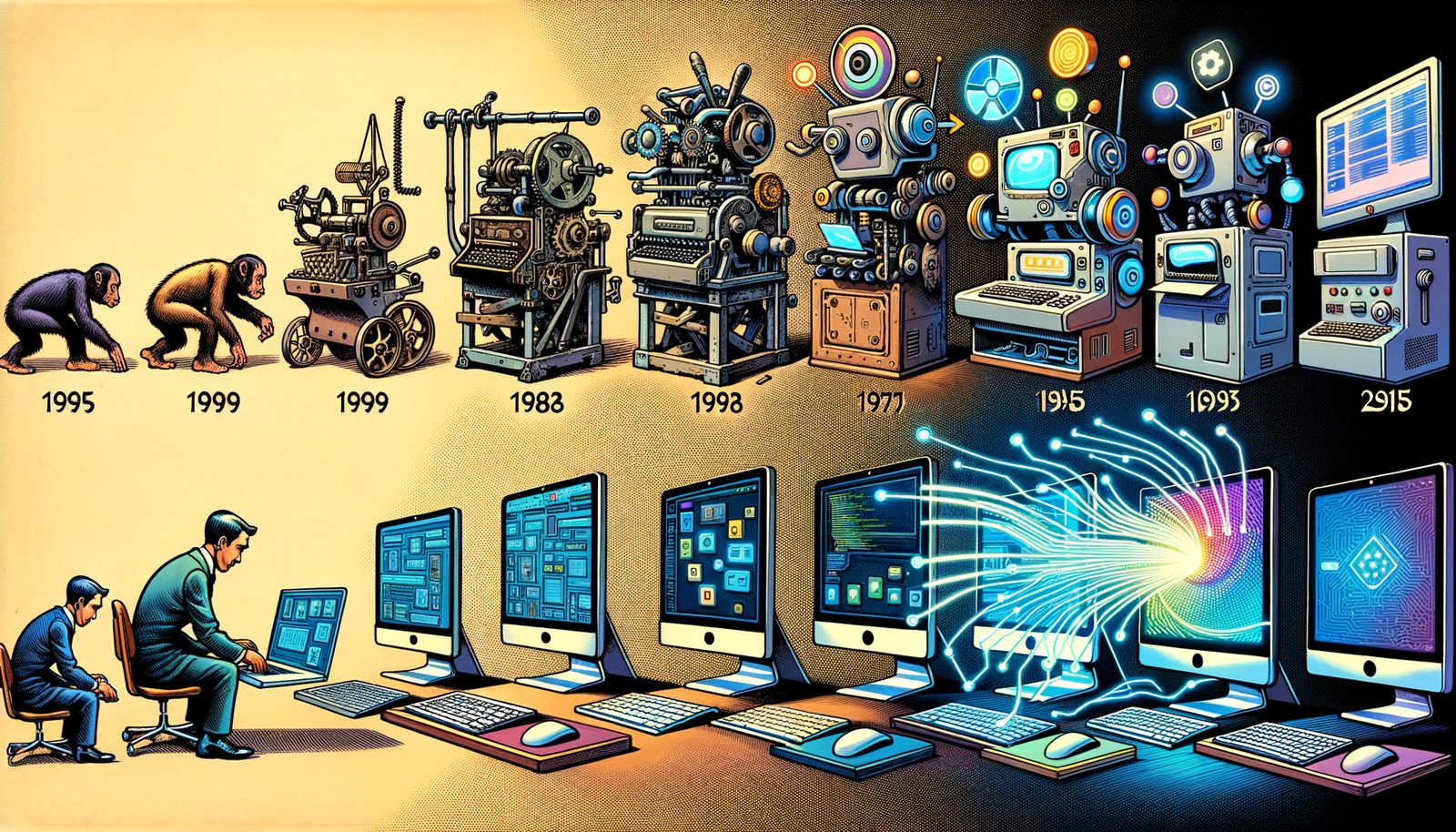Your Cart is Empty
Customer Testimonials
-
"Great customer service. The folks at Novedge were super helpful in navigating a somewhat complicated order including software upgrades and serial numbers in various stages of inactivity. They were friendly and helpful throughout the process.."
Ruben Ruckmark
"Quick & very helpful. We have been using Novedge for years and are very happy with their quick service when we need to make a purchase and excellent support resolving any issues."
Will Woodson
"Scott is the best. He reminds me about subscriptions dates, guides me in the correct direction for updates. He always responds promptly to me. He is literally the reason I continue to work with Novedge and will do so in the future."
Edward Mchugh
"Calvin Lok is “the man”. After my purchase of Sketchup 2021, he called me and provided step-by-step instructions to ease me through difficulties I was having with the setup of my new software."
Mike Borzage
Design Software History: The Evolution of Ergonomic Design Software: From Industrial Roots to AI-Driven Innovations
October 04, 2024 4 min read


Introduction to Ergonomics in Design
Ergonomics, derived from the Greek words "ergon" (work) and "nomos" (laws), is the scientific discipline focused on understanding human interactions within systems and designing products that optimize human well-being and overall system performance. The importance of ergonomics in design cannot be overstated, as it plays a crucial role in enhancing user comfort, safety, and productivity. By integrating ergonomic principles, designers aim to create products and environments that align with the physical and psychological needs of users, thereby reducing the risk of injuries and improving user satisfaction.
Historically, ergonomic considerations have evolved significantly across various design fields. During the Industrial Revolution, the rapid mechanization and mass production led to a heightened awareness of worker efficiency and safety. This period marked the beginning of systematic studies on how work environments and tools could be optimized to fit human capabilities. Over time, the emphasis shifted from merely increasing productivity to enhancing human-centered design, where the focus is on creating products that are not only efficient but also comfortable and intuitive to use. This evolution reflects a broader understanding of the importance of designing for the user's physical and cognitive needs, which continues to influence modern design practices.
Early Developments and Key Figures
In the early 20th century, the foundations of ergonomics were laid by pioneers who recognized the interplay between human capabilities and work performance. One of the most influential figures was Frederick Winslow Taylor, known for his principles of scientific management. Taylor's work focused on optimizing labor productivity by analyzing and standardizing workflows. His studies emphasized the need for adapting tasks to the worker's physical abilities, thereby reducing fatigue and increasing efficiency. This approach highlighted the significance of designing work processes and tools that align with human physiology.
Another notable contributor was Hugo Münsterberg, a German-American psychologist considered a pioneer in applying psychological principles to industrial efficiency. Münsterberg's work in human factors delved into how mental processes affect work performance. He advocated for selecting workers based on psychological testing and designing tasks that matched their cognitive strengths. This early integration of psychological aspects into ergonomics underscored the multidimensional nature of ergonomic design.
Significant milestones in the history of ergonomics emerged from the Industrial Revolution onward. The development of time and motion studies by Frank and Lillian Gilbreth further advanced the field by identifying the most efficient ways to perform tasks. These studies aimed to eliminate unnecessary movements, thereby streamlining work processes. Additionally, World War II played a pivotal role in the evolution of ergonomics as complex machinery and systems required designs that accounted for human limitations and capabilities. This era saw the formalization of ergonomics as a discipline, leading to the establishment of professional societies and increased research into human-centered design principles.
The Rise of Design Tools Focused on Ergonomics
The advancement of technology in the latter half of the 20th century brought about the development of specific design tools that incorporated ergonomic principles. Computer-Aided Design (CAD) software emerged as a revolutionary tool, allowing designers to create detailed models of products with precise measurements and simulations. Companies like Autodesk, with their introduction of AutoCAD in 1982, provided platforms where ergonomic features could be integrated directly into the design process. These tools enabled designers to visualize and adjust products to better fit human dimensions and movements.
Anthropometric data became a cornerstone in shaping ergonomic design tools. By utilizing comprehensive measurements of human body dimensions, designers could tailor products to accommodate a wide range of body sizes and shapes. This integration ensured that products such as furniture, vehicles, and consumer electronics were developed with the user's physical characteristics in mind. Ergonomic modeling within CAD software allowed for the simulation of human interaction with products, predicting potential discomfort or usability issues before physical prototypes were built.
Over time, the increased focus on ergonomics in design tools led to significant improvements in product usability and comfort across various industries. In office furniture design, for example, companies like Herman Miller and Steelcase leveraged ergonomic design tools to create chairs that support proper posture and reduce strain. In automotive design, manufacturers incorporated ergonomic principles to enhance driver comfort and safety, resulting in better seat designs and control placements. The rise of these tools underscored the importance of ergonomics in creating products that not only function effectively but also promote the well-being of users.
- Integration of anthropometric data ensures products accommodate diverse user populations.
- Simulation of human-product interaction helps identify potential ergonomic issues early in the design process.
Contemporary Trends and Future Directions in Ergonomic Design Software
In the modern era, ergonomic design software continues to evolve, embracing cutting-edge technologies to enhance the design process. One of the current trends is the integration of Virtual Reality (VR) and Augmented Reality (AR) into ergonomic assessments. These technologies allow designers to immerse themselves in a virtual environment where they can interact with product designs in real-time. For instance, VR enables the simulation of a workspace, allowing designers to evaluate the ergonomics of equipment placement and movement flow. AR, on the other hand, overlays digital information onto the physical world, facilitating on-site ergonomic evaluations and modifications.
Advancements in Artificial Intelligence (AI) and Machine Learning (ML) are also increasingly informing ergonomics. AI algorithms can analyze vast amounts of data to identify patterns and suggest design improvements that enhance user comfort and efficiency. Machine learning models can predict how different user populations might interact with a product, allowing for more personalized and inclusive design solutions. These technologies contribute to creating designs that adapt to user behaviors and preferences, further embodying the principles of user-centered design.
Looking ahead, the future of ergonomic design tools holds the promise of even greater impact on industries, user experiences, and health outcomes. The continued development of wearable technology and biometric sensors will provide designers with real-time data on how users interact with products, enabling continuous improvement of ergonomic features. Additionally, the emergence of collaborative platforms that utilize cloud computing will allow for more interdisciplinary approaches to ergonomic design, integrating insights from engineers, designers, and health professionals. Ultimately, these advancements will lead to products and environments that not only meet functional needs but also enhance the overall quality of life for users.
- Embracing VR and AR technologies allows for immersive ergonomic evaluations.
- AI and ML contribute to more adaptive and personalized ergonomic designs.
Also in Design News

Cinema 4D Tip: Structured Content Browser Workflow for Cinema 4D Asset Management
January 07, 2026 2 min read
Read MoreSubscribe
Sign up to get the latest on sales, new releases and more …




